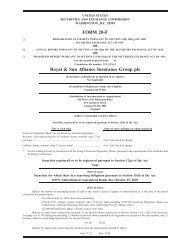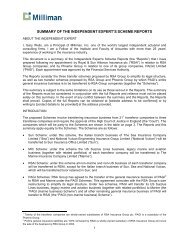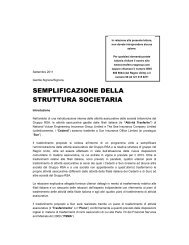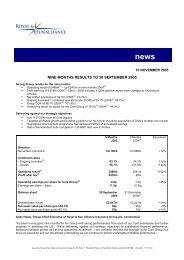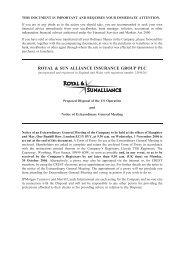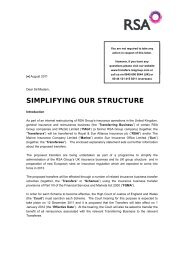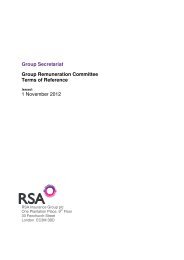RSA RETAIL RESEARCH PAPER2 WEB HR.pdf
RSA RETAIL RESEARCH PAPER2 WEB HR.pdf
RSA RETAIL RESEARCH PAPER2 WEB HR.pdf
You also want an ePaper? Increase the reach of your titles
YUMPU automatically turns print PDFs into web optimized ePapers that Google loves.
DO CONSUMERS REALLY<br />
CARE WHERE THEY BUY?<br />
WE TALK ABOUT ‘THE CONSUMER’, HOWEVER,<br />
IT IS MUCH MORE COMPLEX THAN THAT.<br />
Consumers have varying needs and wants at different times and<br />
depending on how and why they are purchasing. However, there<br />
are some trends that can be clearly seen from various research<br />
papers and individual Retailer successes or failures. These are<br />
forming invaluable reference points for the development of the<br />
Retail proposition.<br />
WILL THEY DELIVER VALUE FOR MONEY?<br />
Consumers have always ranked value for their money pretty highly<br />
in research surveys for Retailers, now it is a clear winner for many.<br />
All indications are that consumers with disposable income are<br />
making much more serious decisions about where they spend<br />
it. ‘The basics’ are coming fi rst for product purchases, and many<br />
‘value’ brands are going from strength to strength as a result. Those<br />
endeavouring to show that they have ‘best prices’ or ‘best packages’<br />
or ‘added value’ are picking up more regular consumers.<br />
But it is not all about having the cheapest price.<br />
A survey of 2,210 UK consumers conducted by Retail Eyes has<br />
found that less than one in fi ve people (17 per cent) intend to<br />
make purchasing decisions based on the lowest possible price.<br />
Tim Ogle, CEO of Retail Eyes, says that rock bottom pricing is<br />
not necessarily the best way to attract, and retain, customers.<br />
“Our research has shown that 83% of shoppers are looking for<br />
added value for their money. Obviously with their margins being<br />
squeezed by rising costs, Retailers need to fi nd cost effective<br />
ways to add value – one of which is through exceptional<br />
customer service”.<br />
Ref. Retail Eyes Jan 2011<br />
Dealing and negotiating are absolutely on the agenda for the<br />
consumer today. With increasing price comparison possibilities<br />
through the use of the web, and encouragement from the media<br />
and social media, consumers are becoming more courageous. In<br />
some countries, consumers now see the face-to-face Retail store<br />
as a way of bringing out their bargaining power. Some Retail brands<br />
are encouraging this further with ‘money back guarantees’ where<br />
lower prices can be found.<br />
The categories customers are spending on are changing too,<br />
refl ecting the more diffi cult fi nancial situations that consumers fi nd<br />
themselves in. Consumers are spending much more on things they<br />
need rather than things they want.<br />
CAN I JUSTIFY THIS PURCHASE?<br />
For a number of years there has been growing spending on ‘luxury’<br />
items, or things that consumers want e.g. the new iPhone or iPad,<br />
the expensive car or the designer handbag.<br />
The implications of the fi nancial crisis and economic impacts have<br />
meant a change in these patterns. This has not stopped consumers<br />
buying luxury items, but it has, in many cases, resulted in a more<br />
serious and discerning consumer selecting carefully their purchases<br />
based on the perceived value and timeless nature of the item<br />
they buy.<br />
Consumers are thinking more carefully about their spending<br />
on different categories and where they would prioritise their<br />
own budgets.<br />
ALLOCATION OF MONTHLY BUDGET<br />
EXPAND<br />
(10% INCREASE IN BUDGET)<br />
Travel/Vacation 29%<br />
Savings/Investments 25%<br />
Recreation/Entertainment 20%<br />
Dining Out 15%<br />
Electronics & Appliances 14%<br />
Apparel 11%<br />
Medical 10%<br />
Education 9%<br />
Transportation 6%<br />
Communication Services 5%<br />
Food & Beverage 5%<br />
Housing 1%<br />
-2% Medical<br />
-3% Housing<br />
-6% Education<br />
-7% Transportation<br />
-8% Food & Beverage<br />
-10% Communication Services<br />
-10% Savings/Investments<br />
-12% Recreation/Entertainment<br />
-12% Travel/Vacation<br />
-14% Electronics & Appliances<br />
-18% Dining Out<br />
-21% Apparel<br />
CONTRACT<br />
(10% DECREASE IN BUDGET)<br />
Ref. Neilsen Global Online Consumer Confi dence Survey, Q3 2011<br />
This research by Neilsen shows where, if consumers had a<br />
contraction in their budget by 10% or an expansion of about 10%,<br />
they would spend or reduce their budget.



